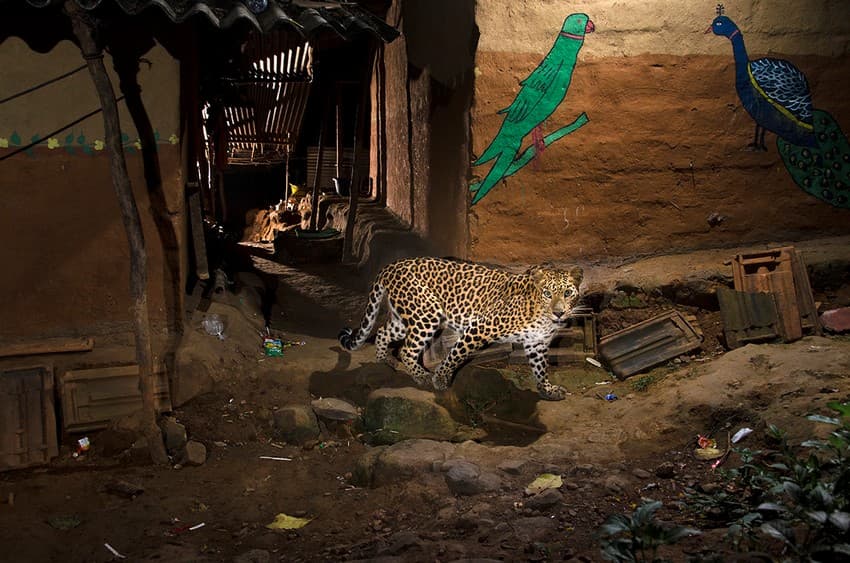A few years ago, I typed three words in the Google Alerts search box, and pressed ‘Create Alert’. The words were: leopard, road, and killed. Since then, I have been getting email alerts almost every 4 days. While all news items are not about leopards being killed on roads, they certainly are about leopards being killed, or about negative interactions between leopards and humans.

A leopard moves around houses of the Warli tribal community in Mumbai’s Aarey Milk Colony. Photo: Nayan Khanolkar
Leopards aren’t fussy about their homes. They are able to adapt to shifting landscapes and shrinking habitats, surviving in small, fragmented forest patches, and even in landscapes completely modified by human activity, where wild prey is almost absent. They aren’t picky eaters, and can prey on anything from insects and rodents to a sambar deer weighing over 80 kilograms. This versatility of a generalist predator, combined with their ability to thrive in a wide range of habitats, has been the key to their survival, making them one of the largest ranging species among big cats. But this adaptability also brings them uncomfortably close to humans.
As an environment journalist trying to understand how leopards and humans share neighbourhoods, I have volunteered with researchers and filmmakers working on the leopards of Mumbai’s Sanjay Gandhi National Park, a 103 sq.km. island of green surrounded by a surging sea of concrete. I have collected and washed leopard scat (excreta) for diet studies that revealed that stray dogs make up a considerable chunk of the Mumbai leopards’ diet. I have spent nights in hides around slums that dot the periphery of the park, next to heaps of garbage, with camerapersons trying to film leopards picking up piglets on thermal cameras.
The leopards of Sanjay Gandhi National Park are good neighbours for people who live along the park’s boundaries. CCTV cameras from slums around the park have recorded them stalking dogs and chickens at night, without bothering the people sleeping in the open. Another interesting example is the leopards in the Akole taluka in the Ahmednagar district of Maharashtra. In this purely agricultural landscape, leopards live and breed in sugarcane fields, with minimum conflict.
But in other places, and over centuries, leopards have occasionally attacked and killed humans, and continue to do so even now. We are yet to fully understand the various, complex drivers of human-leopard interactions, and why some leopards in some places attack humans, while some live alongside humans with little fuss. What we know is that the populations of these threatened big cats living outside Protected Areas (PAs) can be protected, by putting a few measures in place.
Tolerance and reverence for these predators is rooted in our Indian religio-cultural traditions. The need is for policy level changes and improvements that help sustain tolerance and co-existence. Individual leopards that become dangerous to humans must be accurately identified and removed, so that communities don’t become hostile to the entire leopard population. Capacities of the Forest Department should be further built to better handle conflict-like situations, so that fairly innocuous interactions don’t turn chaotic and dangerous. Wherever leopards seem to be coming too close to humans while stalking dogs and other feral animals, measures must be undertaken to reduce stray animal populations that attract leopards in the form of easy prey.
There may not be a ‘one size fits all’ solution for all leopard populations living outside PAs in different parts of the country, in different human-modified landscapes. But if we’re able to support tolerant communities with policies and interventions that compensate and protect them, leopards will be able to continue to breed in the sugarcane fields of Akole, and lounge on roadside benches in Mumbai’s Aarey Colony at night, watching the human world go by, with a wide yawn.
——————————————————————————————————————————————————————
About the author: Rizwan Mithawala is a Conservation Writer with the Wildlife Conservation Trust and a Fellow of the International League of Conservation Writers. He has previously worked as an environment journalist with a national newspaper.
Disclaimer: The author is associated with Wildlife Conservation Trust. The views and opinions expressed in the article are his own and do not necessarily reflect the views and opinions of Wildlife Conservation Trust.
——————————————————————————————————————————————————————
Your donations support our on-ground operations, helping us meet our conservation goals.
——————————————————————————————————————————————————————
Related Links
- Camera Trapping Outside Protected Areas
- Wildlife Week – Unfair Game – Big Cats Lose Prey to Bushmeat Hunters
- Wildlife Week – India’s Big Cats Under Threat
- The Art of Camera Trapping for Conservation
- Facilitating wild felid conservation
- The Hunters, The Strategists and The Prey
- Watch: Female leopard radio-collared at Sanjay Gandhi National Park

